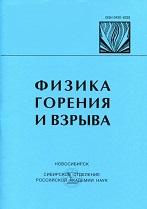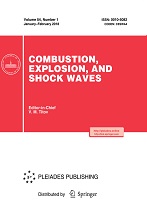|
This article is cited in 12 scientific papers (total in 12 papers)
Effect of the aluminum particle size, solid content, and aluminum/oxygen ratio on the underwater explosion performance of aluminum-based explosives
F. Xiao, W. Gao, J. Li, R. Yang
Beijing Institute of Technology, 100081, Beijing, China
Abstract:
Several aluminum-based explosives are prepared and their underwater explosion performances, including the specific bubble energy and specific shock wave energy, are measured in underwater explosion experiments. The formulation characteristics of the explosives involve the aluminum/oxygen $(\mathrm{Al}/\mathrm{O})$ ratio, aluminum particle size, and the total content of all solid components, including ammonium perchlorate (AP), aluminum $(\mathrm{Al})$, and cyclotrimethylenetrinitramine (RDX). The results indicate that the $\mathrm{Al}/\mathrm{O}$ ratio of the explosives produces a great effect on the specific shock wave energy and specific bubble energy of the explosives. The total specific energy of the explosive reaches the maximum value at $\mathrm{Al}/\mathrm{O}=0.44$. It is notable that an increase in the total solid content (AP, $\mathrm{Al}$, and RDX) in the explosive formulation can effectively increase the specific total energy of the explosives. When the total solid content is increased by $2$ wt.$\%$ in the explosive formulation, the total energy of the explosive can be increased by about $0.1$ times the TNT equivalent. Moreover, the particle size of the aluminum powder can also significantly affect the energy of the explosives. The smaller particle size of the aluminum powder is beneficial to the energy release of aluminum and can increase the total explosion energy.
Keywords:
aluminized explosives, underwater explosion, aluminum/oxygen ratio, specific shock wave energy, specific bubble energy.
Received: 23.08.2019
Revised: 05.11.2019
Accepted: 06.11.2019
Citation:
F. Xiao, W. Gao, J. Li, R. Yang, “Effect of the aluminum particle size, solid content, and aluminum/oxygen ratio on the underwater explosion performance of aluminum-based explosives”, Fizika Goreniya i Vzryva, 56:5 (2020), 91–98; Combustion, Explosion and Shock Waves, 56:5 (2020), 576–584
Linking options:
https://www.mathnet.ru/eng/fgv711 https://www.mathnet.ru/eng/fgv/v56/i5/p91
|


| Statistics & downloads: |
| Abstract page: | 25 |
|





 Contact us:
Contact us: Terms of Use
Terms of Use
 Registration to the website
Registration to the website Logotypes
Logotypes








 Citation in format
Citation in format 
